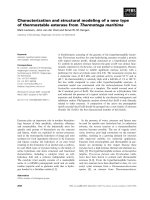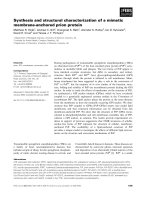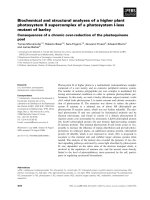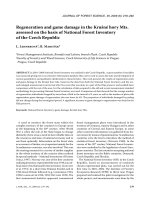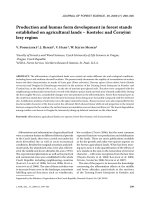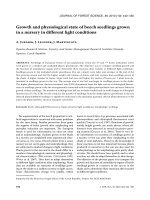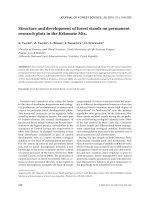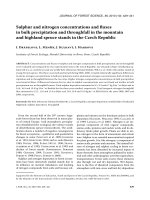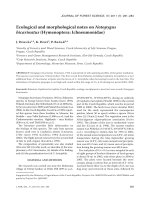Báo cáo lâm nghiệp: "Floristic and structural recovery of a laurel forest community after clear-cutting: A 60 years chronosequence on La Palma (Canary Islands)" ppt
Bạn đang xem bản rút gọn của tài liệu. Xem và tải ngay bản đầy đủ của tài liệu tại đây (767.18 KB, 11 trang )
Ann. For. Sci. 64 (2007) 109–119 109
c
INRA, EDP Sciences, 2007
DOI: 10.1051/forest:2006094
Original article
Floristic and structural recovery of a laurel forest community after
clear-cutting: A 60 years chronosequence on La Palma
(Canary Islands)
Alfredo Manuel B
´
a
,JoséMaríaF
´
-P
a
, Juana María G
´
-M
b
,
Jairo P
˜
b
, José Ramón A
´
a
, Rüdiger O
a
*
, Juan Domingo D
a,c
a
Universidad de La Laguna, Departamento de Ecología, La Laguna, Tenerife, 38206, Spain
b
Universidad de La Laguna, Departamento de Botánica, La Laguna, Tenerife, 38206, Spain
c
Universidad de La Laguna, Departamento de Física Básica, La Laguna, Tenerife, 38206, Spain
(Received 19 June 2006; accepted 31 August 2006)
Abstract – We analyzed a post-clearcut chronosequence (0.5 to 60 years after harvesting) in the laurel forest of La Palma island (Canarian Archipelago)
to determine the recovery of the stands with respect to species composition, richness, life strategies and structural parameters of the canopy. Multivariate
analysis showed that exotic species, as well as annual ruderal species were confined to early-successional stages, while native perennials, typical of laurel
forests, dominated the late-successional stages. Total species richness decreased significantly with time after clear-cutting. The relative fast recovery of
understory native species may be due to low forest floor disturbance during harvesting. Shade-intolerant pioneer, pioneer-remnant and shade-tolerant
late-successional species were the main life strategies of native tree species. Most structural parameters showed a continuous and monotonic increase
(basal area, biomass) or decrease (density, percentage of photosynthetic biomass) during succession. Once clear-cutting, here performed with an interval
of 8 years, is abandoned, the recovery of the laurel forest seems possible due to careful logging that protects the soil and a rapid asexual regenerationof
native tree species, revealing this to be a sustainable management practice.
forest management / laurel forest / species composition / structure / secondary succession
Résumé – Reconstitution floristique et structurale d’une forêt de lauracées après coupe rase : une chronoséquence de 60 ans à La Palma (Îles
Canaries). On a analysé une chronoséquence après coupe rase (0,5 à 60 ans après récolte) dans la forêt de lauracées de l’île de Palma (Archipel des
Canaries) pour déterminer la reconstitution des peuplements pour ce qui concerne la composition spécifique, la richesse et les paramètres structuraux
de la canopée. Une analyse multivariable a montré que les espèces exotiques aussi bien que les espèces rudérales étaient confinées aux premiers stades
de la succession, tandis que les espèces naturelles pérennes typiques de la forêt de lauracées dominaient les derniers stades de la succession. La richesse
spécifique totale a diminué significativement avec le temps après la coupe rase. La reconstitution relativement rapide des espèces naturelles du sous-bois
peut être due à la faible perturbation de la surface du sol forestier au moment de la coupe rase. Les pionnières intolérantes à l’ombre, les pionnières
rémanentes et les tolérantes à l’ombre des stades finaux de la succession constituaient les principales stratégies des espèces naturelles d’arbres. La
plus grande partie des paramètres structuraux ont montré un accroissement continu et monotone (surface terrière, biomasse) ou décroissant (densité,
pourcentage de la biomasse photosynthétique) pendant la succession. Autrefois réalisée ici avec un intervalle de 8 ans la coupe rase est abandonnée,
la reconstitution de la forêt de lauracées semble possible grâce à une exploitation prudente des bois protégeant le sol et une régénération asexuée des
espèces naturelles d’arbres, révélant que ceci est une pratique de gestion durable.
aménagement forestier / forêt de lauracées / composition spécifique / structure / succession secondaire
1. INTRODUCTION
Sustainable forest management is essential to the establish-
ment and maintenance of a society using resources, products
and energy [23]. The impact of harvesting on forest structure
and biodiversity is a topic of continuous debate [16, 19, 39].
Government agency regulation determines what, where and
when timber is harvested in a managed forest, indicating in
some cases which species can be cut [26, 32]. In order to
achieve the goal of sustainable forest and illuminate the de-
bate about harvest impacts, the complex natural forest dynam-
* Corresponding author:
ics and vegetation recovery after anthropic harvesting should
be studied [44].
The harvesting method with greatest potential impact may
be clear-cutting [27, 51]. After clear-cutting, the flora is gener-
ally dominated by early successional species and this has been
reported to delay the floristic recovery of subtropical forests
after clear-cutting [31]. Some late successional plant species
may become locally extinct, if cutting is very frequent [27].
In contrast, early-successional species can become rare due to
seed bank depletion, if natural disturbance regimes are sup-
pressed and cutting intervals are long (>50 y) [42]. In addi-
tion, the type and intensity of forest floor disturbance during
Article published by EDP Sciences and available at or />110 A.M. Bermúdez et al.
harvest can influence the regeneration of ground-layer vegeta-
tion [9,37].
Furthermore, the presence of exotic species in understory
can be related to forest management, as high intensity treat-
ments increase diversity of both native and exotic species [7].
Oceanic islands are especially sensitive to invasion by exotic
species, where invaders can seriously alter function and struc-
ture of forest ecosystems [8, 30, 55]. Given that the mainte-
nance of species diversity and species composition has become
an important goal of forest management [12, 45], more com-
plete knowledge is needed regarding the effects of harvesting
treatments on the floristic composition of understory layers,
especially for fragile island ecosystems with a high number of
endemic species.
The laurel forest is one of the most emblematic commu-
nities of the Canarian archipelago. However, its dynamics re-
mains largely unknown, except for studies on seed bank and
gap dynamics [3], which revealed different regeneration strate-
gies of the most important tree species with respect to seed
bank, sexual and/or asexual reproduction [4, 20, 21]. Never-
theless, the importance of these functional traits has not yet
been confirmed in secondary succession after agricultural use
or harvesting. A recent study on roadside effects in the lau-
rel forests revealed that many light-demanding ruderal herba-
ceous species (both native and exotic) did not penetrate the for-
est further than 5 m from the edge, probably due to the strong
gradient of available light [17]. Allelopathic effects from lau-
rel leaf-litter may also explain this [52]. Consequently, it is
important to consider anthropogenic effects in the study of the
laurel forest dynamics.
Clear-cutting of small areas of laurel forest stands is the
dominant silvicultural technique used on La Palma, and the
products have several uses in agriculture [10,24]. Historically,
the main laurel forest products have been: (i) charcoal obtained
from stems (5–10 cm of diameter) of mainly Erica arborea
and Myrica faya [10], (ii) several agricultural tools from stems
3–10 cm of diameter and 60–300 cm of height and (iii) green
litter for compost production (once used as cattle bed where it
is mixed with their excrements).
However, in recent years the most demanded laurel-forest
product has been the green litter for compost production in ba-
nana plantations. Thus, forest workers have requested a reduc-
tion of the cutting time from the local environmental authority.
Today the cutting interval has decreased from 10 to 7–8 years,
which is considered by forest owners and workers to be ade-
quate for economical exploitation of the stand [10].
Regarding the recovery of a stand after a clearcut, there
is little information on environmental parameters (light inci-
dence, soil properties), species composition, structural char-
acteristics of the tree stands (basal area, biomass, percentage
of photosynthetic biomass, vegetative sprouting), and the ex-
ploitation has been conducted by trial and error until present.
Our aims were: (a) to analyze the floristic and structural
changes in laurel forest recovery after cessation of clear-
cutting using a 60-years chronosequence; (b) to characterize
the role and threats of exotic plant species in the successional
process; (c) to confirm previously defined regeneration strate-
gies and functional traits of native tree species, and (d) to eval-
uate the actual harvesting method with respect to economical
exploitation and sustainability of the laurel-forest on the is-
land.
2. MATERIALS AND METHODS
2.1. Study site
The study was carried out on La Palma, in an area known locally
as “Pajonales” (Fig. 1). “Unidad Insular de Medio Ambiente” man-
ages this area, and part of the site is within the protected area “Parque
Natural de Cumbre Vieja”. This area has been designated to meet
the timber and woody biomass requirements of the local population;
different sectors are assigned for harvesting in different years. The
mean altitude of the study site is 1100 m (altitudinal range: 200 m)
and most slopes face east. The bedrock is volcanic, with an age of 7–
20 Ky [14]; the soils have been classified as umbric Andisols [47].
The mean annual precipitation is approximately 960 mm and the
mean temperature is 13.6
◦
C[2].
The area is dominated by secondary laurel forest stands, with Er-
ica arborea, Laurus novocanariensis,andMyrica faya being the most
abundant tree species. Other tree species (Ilex canariensis, Persea in-
dica, Viburnum tinus) are present with lesser abundance in the study
site. Old-growth laurel forests do not exist in the vicinity and are con-
fined to steeper slopes in the northeastern part of the island. For fur-
ther information about the vegetation of the area, see [13] and[49].
Nomenclature of vascular plant species followed [28].
2.2. Design of the experiment
Although the chronosequence approach (space-for-time substitu-
tion, [40]) has some disadvantages such as possible small differences
between the plots with regard to site history, edaphic and microcli-
matic conditions or availability of propagules [6, 40], it has been
proven an adequate method to study secondary succession [15, 22].
Thus, seven areas, all between 0.5 and 3 ha, and with differing times
since the last harvest (0.5, 1, 3, 8, 15, 25 and 60 years after harvest-
ing, “YAH”), but with very similar environmental conditions were
selected in the study area. The dates of harvest for the different areas
were obtained from the insular government “Cabildo Insular de La
Palma” and from 11 aerial photographs of different years.
At each site of the chronosequence, three square plots of 25 m
2
(5 × 5 m) were systematically selected at regular intervals of 20 to
100 m along a transect, according to the size of the site. To avoid bor-
der effects or “current” anthropogenic disturbances, plots were placed
at least 15 m from the road. On these destructive plots, we harvested
following the traditional clearcutting technique of the island, using
five-to six-man groups, with knifes and “machetes” and cutting all
the vegetation almost at ground level. In the absence of any mech-
anization system, sampling an area for 100 m
2
takes approximately
one day.
We determined density and basal area of all stems over 2.5 cm
DBH (diameter at breast height, including all basal sprouts over that
measurement), indicating if the trees were dead or alive, as well as
mean aerial biomass (we weighed the total above-ground biomass of
the tree), density of living trees, mean tree height, number of suckers
(defined as stems taller than 1.5 m and less than 2.5 cm DBH), pho-
tosynthetic biomass (we weighed all the leaves of all individuals),
Laurel forest recovery after clear-cutting 111
Figure 1. La Palma Island, indicating the location of the study area.
and the regeneration density of tree species (number of seedlings and
saplings). We also measured maximum sucker height, density of dead
suckers, dead biomass, and calculated the percentage of the photosyn-
thetic biomass in relation to the total above-ground biomass (LMR,
leaf mass ratio) [48]. We did not destructively sample the 60-year
plots.
In each plot, we collected soil between 0–20 cm below the sur-
face (determined after litter removal) at five random points. We made
a single sample of approximately 1 kg for each plot, following the
Mascarell et al. [34] method. All the samples were analyzed at “In-
stituto de Recursos Naturales y Agrobiología de Canarias”. The fol-
lowing parameters were measured for each sample: pH, organic mat-
ter (%), Olsen phosphorus (ppm) and exchangeable cations (calcium,
sodium, potassium, magnesium extractable in ammonium acetate at
ph 7 (ppm)). Finally, we also took litter (dry necromass expressed in
kg/m
2
)infive1m
2
square subplots randomly located within the plot
and light incidence (expressed in Klux) at the ground level in all the
chronosequence.
We located systematically ten 25 m
2
plots in each site to deter-
mine species richness. All the vascular plant species were recorded
(see appendix) and some of them collected for identification in the
laboratory. These permanent plots will be continuously monitored
in future years. Species were classified with regard to introduction
status (exotic or native) and life form type (annual, perennial herba-
ceous, woody), following recently published checklists for the whole
archipelago [1, 50] and one for the island of El Hierro [53].
2.3. Statistical analysis
Ordination techniques help to explain community variation [25],
and they can be used to evaluate trends through time as well as
space [5, 38, 54]. We used Principal Components Analysis (PCA, us-
ing CANOCO; [54]) to examine the relationships among the canopy
parameters during the chronosequence (weight of green biomass,
number of suckers, height of the trees, dead biomass weight, density
of live trees, density of dead trees, number of basal sprouts, maximum
height of the plot and aerial biomass). We separately applied PCA
to relate soil parameters (pH, organic matter, Olsen phosphorus, and
extractable changeable cations) to the chronosequence. Since the gra-
dient length of the ordination exceeded 2.5 SD (standard deviations),
we decided to use Detrended Correspondence Analysis (DCA; [29])
instead of PCA to examine how species composition changed through
the chronosequence. DCA is based on a uni-modal species reponse
to the gradient. DCA analyses were carried out with species pres-
ence data. Non-parametric Kruskal Wallis tests were used to test dif-
ferences between post-harvest stages within the chronosequence for
species richness data and variables of light incidence and litter.
3. RESULTS
Levels of light incidence at ground level (Fig. 2a) changed
significantly with time since harvesting (χ
2
= 16.4, P =
0.012), dropping dramatically during the three first years af-
ter the harvest (YAH), from 2176 µmol/m
2
s0.5YAHtoless
than 50 µmol/m
2
s 3 YAH. Only 15 years after the harvest the
light incidence began to recover very slowly, reaching values
of ca.118 µmol/m
2
s (10% of canopy light incidence) at the
60 years plot. Litter accumulation on the soil changed also sig-
nificantly during succession (χ
2
= 15.1, P = 0.019), achiev-
ing a minimum of 0.3 kg/m
2
one YAH and then increasing to
25 YAH (Fig. 2b), where it stabilized at ca. 1.2–1.3 kg dry
necromass/m
2
. The amount of litter recorded six months after
the harvest (ca. 0.6 kg/m
2
) is very likely the rest of the litter
layer of the pre-harvested vegetation.
We found 54 vascular plant species in our plots along
the chronosequence (Tab. I). However, only seven have been
present in all the ages, the 3 tree species analyzed (Erica
arborea, Myrica faya and Laurus novocanariensis), plus 2
ferns (Asplenium onopteris and Pteridium aquilinum)andtwo
herbs (Geranium purpureum and Pericallis papyracea). Alter-
natively, up to 14 plant species have been only recorded in one
age of the chronosequence. The mean species richness per age
(Fig. 2c), changed significantly with time after abandonment
(χ
2
= 60.8, P < 0.00001), decreasing from 21 species one
year after the harvest to just 5 species (including the 3 studied
tree species) 25 years later. Only in the 60 years plot an in-
crement of the species diversity (ca. 10 species) was observed.
Mean number of annual and exotic species showed the same
temporal trend (χ
2
= 62.4andχ
2
= 52.8, respectively, both
P < 0.00001).
Exotic species richness peaked one year after harvesting,
when we recorded 5 species per plot (25% of the overall rich-
ness), while they were almost absent at the 25 years old stage
(Fig. 2c). At the end of the observed chronosequence, only
two exotic species persisted in the understory of the closed
canopy: the woody species Ageratina adenophora and the an-
nual climbing herb Galium aparine. During the first three
112 A.M. Bermúdez et al.
Table I. List of all vascular plant species found in the chronosequence
plots. Abbreviations: P: perennials species; A: annual species; E: en-
demic species; I: introduced species, N: native species.
Chronosequence plots (years)
Species 0,5 1 3 8 15 25 60
Adenocarpus foliolosus PE X
Ageratina adenophora P I X XXX X X
Agrostis castellana PI X
Aira caryophyllea AN X XX
Anagallis arvensis AN X XX
Aphanes microcarpa AN X X
Arrhenatherum elatium PI XX
Asplenium onopteris PN X XXX X X X
Asterolinon linum-stellatum AN X XX X
Brachypodium sylvaticum PN X
Briza minor AN X X
Calamintha sylvatica PN X
Car duus clavulatus AE X X
Car ex divulsa PN X X
Cedr onella canariensis PE X X X X
Centaurea melitens is AN X
Conyza bonariensis AI XX
Cistus symphytifolius PE X
Dryopteris oligodonta PE X XXXX
Ebingeria elegans AN X
Erica arborea PN X XXX X X X
Galactites tomentosa AI XX
Gallium aparine AI X XXXXX
Gallium parisiense AN X XX
Gallium scabrum PN X XXX X X
Geranium cf. molle AN X X
Geranium purpur eum AN X XXXX X X
Gnaphalium luteo-album AN X
Hypericum grandifolium PE X XXXX X
Juncus bufonius PN X
Laurus no vocanariensis PN X XXX X X X
Lotus angustissimus AI XX
Mercurialis annua AI XX X
Moehringia pentandra AN X XXXX X
Myosotis latifolia PN XXXX
Myrica faya PN X XXX X X X
Neotinea maculata PN X
Origanum virens PN X XXX
Ornithopus pinnatus AI X
Pericallis papyracea PE X XXXX X X
Pteridium aquilinum PN X XXXX X X
Sherar dia arvensis AN X XX X
Sonchus asper AI X X
Sonchus oleraceus AI XXX
Tamus edulis PN X X X
Stachys arvensis AN X
Torilis arvensis AN X XX
Trifolium dubium AN X X
Trifolium ligusticum AN X X
Tuberaria guttata AN X XX
Urtica morifolia PN X
Vicea grex sativa AI X
Vicia lutea AN X
Vicia pubescens AN X
Figure 2. Mean values of chronosequence plot characteristics: (a)
Light incidence, (b) litter, (c) vascular plant species richness (total
richness, annuals, exotics).
years of abandonment, annuals accounted for more than 50%
of the total richness, while in the second phase, once the
canopy had closed, woody and perennial herbaceous species
dominated the floristic spectrum (Fig. 2c). Fourteen (78%) of
the 18 late-successional species, recorded in the last two stages
(25–60 YAH), were already present within the first year after
clear-cutting.
The three tree species exhibited different patterns of
changes in structural parameters along the chronosequence
(Fig. 3). The community aerial biomass increased contin-
uously through the chronosequence due to the increase
in biomass of Myrica faya, while the increase of Lau-
rus novocanariensis was less apparent, and Erica arborea
Laurel forest recovery after clear-cutting 113
Figure 3. Mean values of chronosequence plot characteristics for different species (Erica arborea, Myrica faya and Laurus novocanariensis)
and for the total community. Bars are standard deviation from the mean. (a) Mean aerial biomass; (b) mean basal area; (c) density; (d) mean
height; (e) mean number suckers per tree; (f) photosynthetic biomass; (g) regeneration density.
114 A.M. Bermúdez et al.
Figure 4. Principal Components Analysis of some of the canopy variables of the plots. Axis I eigenvalue was 0.83 (83% of the cumulative
percentage of variance), and axis II eigenvalue was 0.14 (97% of the cumulative percentage of variance). ba: basal area; biomass: total aerial
biomass; dead_b: dead biomass; msh: maximum sucker height; height: canopy height; Pho_b: photosynthetic biomass; No.: density of trees;
No.ds: density of dead suckers; acum_pho: percentage of photosynthetic biomass; No.as: density of suckers.
decreased 15 years post-harvesting; however, high variability
was present along the chronosequence (Fig. 3a). Basal area
(analyzed for 60 years) showed a very different pattern. Dom-
inance of Myrica faya dropped dramatically after 25 years.
Laurus novocanariensis became the dominant species with re-
spect to basal area in the 60 YAH sites. Values for the total plot
showed some stabilization between 25 and 60 years, with an
increase of only 6 m
2
ha
−1
of basal area in 35 years (Fig. 3b).
Tree density decreased for all the species, with Erica arborea
showing the highest reduction (Fig. 3c). Tree height increased
similarly for the three species (approximately 6 m) during the
first 25 years (Fig. 3d).
The number of suckers dropped for all species, with the
strongest decrease for Erica arborea (Fig. 3e). The percent-
age of photosynthetic biomass (LMR) decreased immediately
after harvesting and stabilized after 15 years for all the tree
species. Although during the first years after harvesting Er-
ica and Myrica showed a larger number of suckers per stump
than Laurus, this species revealed the highest leaf mass ratio
at the end of the chronosequence (Fig. 3f), as well as a high
basal area (Fig. 3b). This indicates a slower recovery of Lau-
rus to the exploitation, and its eventual domination at a very
late successional stage.
Although total density of seedlings and saplings did not
show clear patterns along the chronosequence (Fig. 3g), re-
generation of Erica arborea and Myrica faya by seedlings and
saplings disappeared almost completely after the third year,
while Laurus novocanariensis maintained similar values along
the chronosequence, but with a high variability.
Ordination of the canopy parameters with a PCA revealed
that these parameters are useful to discriminate the plots in re-
lation to the time after harvesting (Fig. 4). Early successional
stages (0.5 to 3 YAH) are discriminated from one another
along Axis 2 on the basis of decreasing number of suckers per
stump with increasing stand age, and mid to late successional
stages (8 to 25 YAH) are discriminated from one another along
Axis 1 on the basis of increasing basal area and aerial biomass
and decreasing values of all other structural measures.
The DCA ordination based on species presence was also
consistent in discriminating the plots (Fig. 5). Sites 0.5–3 YAH
were well discriminated from the rest of the plots by DCA
axis I, separating ruderal species (e.g., Carex divulsa, Vi-
cia lutea, Arrh enatherum elatium) dominating during the first
three years after harvesting from laurel forest trees (such as
Erica arborea, Laurus novocanariensis and Myrica faya)and
perennial ferns and herbs (Asplenium onopteris, Dryopteris
oligodonta, Tamus edulis or Myosotis latifolia), typical of mid
to late successional stages (8–60 YAH plots, Fig. 6). Sites 8–
60 YAH can be slightly discriminated by axis I but not as
clearly as between this site group and the 0.5–3 YAH sites.
Plots 3 YAH are discriminated from plots 0.5–1 YAH through
axis II.
PCA analysis was not able to discriminate the soil parame-
ters in relation to time after harvesting (Fig. 7), indicating that
the soil parameters analyzed are more affected by local sub-
strate heterogeneity than by time after the harvest, being Ca,
Na and K contents related to the first axis, and P, organic mat-
ter and pH the soil features correlated with the second axis.
Laurel forest recovery after clear-cutting 115
Figure 5. Detrended Correspondence Analysis Axes I and II. Plot coordinates are displayed. Each different chronosequence age has 10 different
plots (from “a” to “j”). Envelopes surround 95% of all the plots with the same time after harvesting, covering the minimum possible area. Axis I
eigenvalue is 2.40 (cumulative percentage of the variance: 15.58), and axis II eigenvalue was 2.03 (cumulative percentage of the variance: 24.3).
4. DISCUSSION
4.1. Floristic and structural changes
Ordination of species composition showed a clear succes-
sional trend coinciding with the recovery of the stand. DCA
Axis I separated ruderal species, mostly annuals dominating
during the first three years, from woody species highly re-
lated with the laurel forest whose importance increased in
the second phase of succession. This gradient represents also
a replacement of life forms, typical in secondary succes-
sion [38, 44]. It has been reported that ruderal annuals and
exotic herbaceous plants, most of them light-demanding, are
confined to heavily disturbed sites (like roadsides), not being
able to grow under a closed laurel forest canopy probably due
to competition for light [17]. How far allelopathic effects of lit-
ter from laurel leaves prevent those species from establishing
inside the forest is topic for future studies [51].
Once the native tree species, all of them already present at
the beginning of succession but with a low abundance, have
reached to close the canopy, only small changes in species
composition after 15 years post-harvesting were observed.
These results agree with previous findings that tree fall gaps,
the main natural dynamics in the laurel forest, are not expected
to change the species composition [4]. Furthermore, they sup-
port the succession concept of the initial floristic composi-
tion [18], indicating that species have to establish early dur-
ing succession before competition has increased and resources
availability has decreased. In accordance with that, we did not
note a delay of floristic recovery due to the dominance of pio-
neer tree species [31], probably because the pioneer tree Erica
arborea was replaced by the late-successional species Laurus
novocanariensis, already present at the beginning of the sec-
ondary succession.
The floristic variation represented by the second DCA axis
is more difficult to interpret. The 3 YAH stage is separated by
this axis probably due to species such as Cistus symphytifolius,
Gnaphalium luteo-album, Centaurea melitensis and Asteroli-
non linum-stellatum, not shared with any other stage. This can
rather be related to special site conditions and/or landscape
position than to successional trends.
Most of the structural parameters changed considerably
with time since harvesting, indicating clearly a structural re-
covery of the vegetation after the clearcutting, which can be di-
vided into three different stages: (i) the initial stage, between 0
and 1 YAH, showing the highest percentage of photosynthetic
biomass and the highest number of suckers in the chronose-
quence, (ii) the intermediate stage, until 15–25 YAH, with high
rates of mortality and selection of suckers being the growth in
height more important than the production of new suckers, and
(iii) the final stage, after 15–25 years, the forest begins to sta-
bilize.
Soil parameters such as total nitrogen and percentage of or-
ganic matter cannot be related with time after harvesting, de-
spite the fact that this relationship has been found in other stud-
ies [33]. The increase in output of nutrients due to erosion [11]
was not supported by our results, as long as the decrease or in-
crease of nutrients is not related with the chronosequence, sug-
gesting that erosion due to this type of harvesting is not as im-
portant as in other forests, what will make shorter the recovery
time [43]. In addition, it is important to note that slope values
are low for all plots of the study (3–6 sexagesimal degrees).
116 A.M. Bermúdez et al.
Figure 6. Detrended Correspondence Analysis Axes I and II. Symbol type: circle: annuals; rhombs: perennial herbs; triangles: shrubs;
squares: trees; filled symbols = exotic species; open symbols: native species. Species coordinates: Adenocarpus foliolosus: Adenfoli; Ager-
atina adenophora: Ageraden; Agrostis castellana: Agrocast; Aira caryophyllea: Airacary; Anagallis arvensis: Anagarve; Aphanes micro-
carpa: Aphamicr; Arrhenatherum elatium: Arrhelat; Asplenium onopteris: Asplonop; Aster olinon linum-stellatum: Astelino; Brachypodium
sylvaticum: Bracsylv; Briza minor: Brizmino; Calamintha sylvatica: Calasylv; Carduus clavulatus: Cardclav; Carex divulsa: Caredivu; Ce-
dronella canariensis: Cedr cana; Centaurea melitensis: Centmeli; Conyza bonariensis: Conybona; Cistus symphytifolius: Cistsymp; Dryopteris
oligodonta: Dryoolig; Ebingeria elegans: Ebineleg; Erica arborea: Ericarbo; Galactites tomentosa: Galatome; Gallium aparine: Gallapar;
Gallium parisiense: Gallpari; Gallium scabrum: Gallscab; Geranium cf. molle: Ger amoll; Geranium purpureum: Ger apurp; Gnaphalium
luteo-album: Gnaplute; Hypericum grandifolium: Hypegran; J uncus bufonius: Juncbufo; Laurus novocanariensis: Laurazor; Lotus angustis-
simus: Lotuangu; Mercurialis annua: Mercuannu; Moehringia pentandra: Moehpent; Myosotis latifolia: Myoslati; Myrica faya: Myrifaya;
Neotinea maculata: Neotmacu; Origanum virens: Origvire; Ornithopus pinnatus: Ornipinn; Pericallis papyracea: Peripapy; Pteridium aquil-
inum: Pteraqui; Sherardia arvensis: Sherarve; Sonchus asper: Soncaspe; Sonchus oleraceus: Soncoler; Tamus edulis: Tamuedul; Stachys
arvensis: Stacarve; Torilis arvensis: Toriarve; Trifolium dubium: Trifdubi; Trifolium ligusticum: Trifligu; Tuberaria guttata: Tubegutt; Urtica
morifolia: Urtimori; Vicia gre x. sativa: Vicisati; Vicia lutea: Vicilute; Vicia pubescens: Vicipube.
Minimizing forest floor disturbances favors the natural regen-
eration and recover of the species composition [37, 46].
4.2. Species richness and exotic species
Total species richness is highest just after clear-cutting
(0.5–1 year), which can be attributed as much to the rapid
establishment of ruderal species with a high dispersal capac-
ity [42], as to the native species still present in form of seeds
or suckers after logging. The rapid closure of the canopy af-
ter 3 YAH reduced the number of species, in agreement with
the observed elimination of light-demanding ruderal species.
The late increase in richness at the end of the chronosequence
could indicate that floristic recovery has not finished and that
shade-tolerant native species continue to immigrate slowly due
to limited dispersal capacity and/or limited propagule pres-
sure.
Since most of the exotic species were annuals or herba-
ceous, they were excluded along the chronosequence, and thus
occurred at very low abundances at the advanced stages. Al-
though the observed replacement of exotic species by native
species seems to be a general trait of secondary succession
Laurel forest recovery after clear-cutting 117
Figure 7. Principal Components Analysis of soil parameters. Axis I eigenvalue was 0.94 (94% of the cumulative percentage of variance), and
axis II eigenvalue was 0.03 (97% of the cumulative percentage of variance). P Olsen: Olsen phosphorus; O.M.: organic matter; pH: pH; Na:
extractable sodium; K: extractable potassium; Ca: extractable calcium; Mg: extractable magnesium.
related to resource availability, disturbance and life history
traits of the invading species [22, 35, 38], it is surprising that,
up to now, no exotic tree species is reported to have seri-
ously invaded laurel forest stands on the Canaries, in contrast
to other oceanic islands, where invaders caused tremendous
impacts on native evergreen forests [8, 30, 55]. The great
threat for the Canarian laurel forest could be some shade-
tolerant, fast growing colonizer of disturbed sites with high
photosynthetic efficiency, good asexual and sexual reproduc-
tion, i.e. with combined characteristics of a pioneer and late-
successional species. Such a species could be Pittosporum
undulatum, which has invaded the laurel forests of Madeira
and the Azores as well as tropical forest on Jamaica [8].
4.3. Regeneration strategies of tree species
Results show a different successional pattern for each of the
tree species. Sexual regeneration after a clear-cut is only pos-
sible for pioneer species, possessing seed banks where germi-
nation is prevented in close canopies but common on logged
areas due to the heliophylic character of their seedlings. This
is the case of Erica, and to some extent of Myrica as well [21],
which present seedlings along the chronosequence until the
canopy is too closed (> 3 YAH) to receive enough light on
the forest floor. Subsequently, only seeds of mature species,
such as Laurus [21], can germinate under a closed canopy.
Thus, Laurus seedlings prevailed in the chronosequence after
the first years, and those present in the 0.5–3 YAH plots, are
likely survivors of the pre-logged vegetation.
Although often considered a pioneer species, Myrica faya
has recently been classified as a pioneer-remnant species
due to its ability to persist under closed canopies through
suckers [21]. After 25 years post harvest, the basal area of
Myrica faya dropped in favor of Laurus novocanariensis,a
shade tolerant species. Canopy projection models also predict
this pattern for the laurel forest of Tenerife; a higher dom-
inance of Laurus novocanariensis is projected in the future
even in well-conserved forests [5]. Conditions in 60 YAH sites
are likely more favorable for shade-tolerant species. The ob-
served decrease of leaf mass ratio in the first 15 years indi-
cates a shift in biomass allocation from leaves to stems, which
is characteristic during forest succession [41].
4.4. Sustainable management practices in the laurel
forest of La Palma
After 8 years the structure of the stand is far from the nat-
ural structure of the forest; however, at this moment trees typ-
ically reach an adequate size for exploitation [10], whereas
the community still supplies an important percentage of green
biomass and a sufficient number of well-developed suckers,
thus matching the necessities of both agricultural tools and
118 A.M. Bermúdez et al.
compost precursors. The decrease in photosynthetic biomass
and the increase in basal area between 8 and 15 YAH coin-
cide with a reduction in the density and quality of the desired
harvestable material.
The species composition of the sites did not show dras-
tic differences among 8–60 YAH sites, which is probably re-
lated to the high quality of the soils and the low disturbance
of the forest floor during the logging. Furthermore, no inva-
sive species have been detected and no remnant species are
favoured by the harvesting, suggesting a high degree of sus-
tainability with this management practices. However, some
species (Viburnum tinus, Ilex canariensis), which are very
abundant in similar areas of other islands, as well as on La
Palma, show a low abundance in these managed areas. This
can be related to the long-term management practices.
In short, results suggest that the current historical manage-
ment of laurel forest (harvesting with 8 years intervals) does
not allow the full structural recovery of the stand. However, al-
though we cannot compare with old-growth stands in this case,
species composition seems to recover well and environmen-
tal conditions are favorable for the recovery of the stand once
these traditional practices are abandoned due to the progres-
sive reduction of demand for these products [36]. Until then,
the traditional management of the stand is only meeting the
social and economical requirements for part of the population
of La Palma.
Acknowledgements: We thank the “Cabildo de La Palma” for the
support of the project. Suzanne McAlister and Jerry Husak (Okla-
homa State University) revised the manuscript and supplied valuable
comments.
REFERENCES
[1] Acebes Ginovés J.R., Pteridophyta, spermatophyta, in: Izquierdo
I., Martín J.L., Zurita N., Arechavaleta M. (Eds.), Lista de es-
pecies silvestres de Canarias (hongos, plantas y animales terrestres),
Consejería de Medio Ambiente y Ordenación Territorial, Gobierno
de Canarias, 2004, pp. 96–143.
[2] Arco M.J. del, Acebes J.R., Perez P.L., Marrero M.V.,
Bioclimatology and climatophilous vegetation of El Hierro
(Part 2) and La Palma (Canary Islands), Phytocoenologia 29 (1999)
253–290.
[3] Arévalo J.R., Organización espacial y temporal de la laurisilva de
Anaga-Tenerife, Islas Canarias, Ph.D. thesis, Universidad de La
Laguna, La Laguna, 1998.
[4] Arévalo J.R., Fernández-Palacios J.M., Treefall gap characteristics
and regeneration in the laurel forest of Tenerife, J. Veg. Sci. 9 (1998)
297–306.
[5] Arévalo J.R., Fernández-Palacios J.M., Palmer M.W., Tree regener-
ation and future dynamics of the laurel forest on Tenerife, Canary
Islands, J. Veg. Sci. 10 (1999) 861–868.
[6] Bakker J.P., Olff H., Willems J.H., Zobel M., Why do we need per-
manent plots in the study of long-term vegetation dynamics? J. Veg.
Sci. 7 (1996) 147–156.
[7] Battles J.J., Shlisk A.J., Barrett R.H., Heald R.C., Allen-Día B.H.,
The effects of forest management on plant species diversity in a
Sierran conifer forest, For. Ecol. Manage. 146 (2001) 211–222.
[8] Bellingham P.J., Tanner E.V.J., Healey J.R., Hurricane disturbance
accelerates invasion by the alien tree Pittosporum undulatum in
Jamaican montane rain forests, J. Veg. Sci. 16 (2005) 675–684.
[9] Bergstedt J., Milberg P., The impact of logging intensity on field-
layer vegetation in Swedish boreal forests, For. Ecol. Manage. 154
(2001) 105–115.
[10] Bermúdez A.M., Análisis de la regeneración del monterverde tras
el abandono de su aprovechamiento forestal. El caso de Breña Baja,
La Palma, Graduation thesis, University of La Laguna, La Laguna,
2002.
[11] Bormann F.H., Likens G.E., Patterns and processes in forested
ecosystems, Springer-Verlag, Berlin, 1979.
[12] Burton P.J., Balisky A.C., Coward L.P., Cumming S.G., Kneeshaw
D.D., The value of managing for biodiversity, For. Chron. 68 (1992)
225–237.
[13] Ceballos L., Ortuño F., Vegetación y Flora Forestal de las Canarias
Occidentales, 2
a
ed., Cabildo Insular de Tenerife, Santa Cruz de
Tenerife, 1974.
[14] Carracedo J.C., Day S., Guillou H., Staudigel H., La Palma excur-
sion guide book and geological map, International workshop on vol-
canism and volcanic hazards in immature interplate oceanic islands,
La Palma, 1997.
[15] Debussche M., Escarré J., Lepart J., Houssard C., Lavorel S.,
Changes in Mediterranean plant succession: old-fields revisited, J.
Veg. Sci. (1996) 519–526.
[16] Decocq G., Aubert M., Dupont F., Bardat J., Delelis A.,
Silviculture-driven vegetation change in a European temperate de-
ciduous forest, Ann. For. Sci. 62 (2005) 313–323.
[17] Delgado García J.D., Efectos de borde de las carreteras en la
laurisilva y el pinar de Tenerife (Islas Canarias), Ph.D. thesis,
Universidad de La Laguna, La Laguna, 2003.
[18] Egler F.E., Vegetation science concepts. I. Initial floristic composi-
tion, a factor in old-field development, Vegetatio 4 (1954) 412–417.
[19] Falcao A.O., Borges J.G., Designing decision support tools for
Mediterranean forest ecosystems management: a case study in
Portugal, Ann. For. Sci. 62 (2005) 751–760.
[20] Fernández-Palacios J.M., Arévalo J.R., Regeneration strategies of
tree species in the laurel forest of Tenerife (The Canary Islands),
Plant Ecol. 137 (1998) 21–29.
[21] Fernández-Palacios J.M., Arévalo J.R., González-Delgado G.,
Delgado J.D., Otto R., Estrategias de regeneración en la laurisilva,
Makaronesia 6 (2004) 90–101.
[22] Foster B.L., Tilman D., Dynamic and static view of succession:
Testing the descriptive power of the chronosequence approach,
Plant Ecol. 146 (2000) 1–10.
[23] Fujimori T., Ecological and silvicultural strategies for sustainable
forest management, Elsevier, Amsterdam, 2001.
[24] García J.L., Estudio socioeconómico del aprovechamiento forestal
del monteverde en La Palma, Memoria Final, Fundación-Empresa
Universidad, Universidad de La Laguna, La Laguna, 2001.
[25] Gauch H.G. Jr., Multivariate Analysis in Community Ecology,
Cambridge University Press, Cambridge, 1982.
[26] González J.R., Pukkala T., Palahí M., Optimising the management
of Pinus sylvestris L. stand under risk of fire in Catalonia (north-east
of Spain), Ann. For. Sci. 62 (2005) 493–501.
[27] Hannerz M., Hånell B., Effects on the flora in Norway spruce forests
following clearcutting and shelterwood cutting, For. Ecol. Manage.
90 (1997) 29–49.
[28] Hansen A., Sunding P., Flora of Macaronesia. Checklist of vascular
plants, 3th ed., Sommerfeltia 1 (1993) 1–167.
[29] Hill M.O., Gauch H.J. Jr., Detrended correspondence analysis: an
improved ordination technique, Vegetatio 42 (1980) 47–58.
Laurel forest recovery after clear-cutting 119
[30] Hughes R.F., Denslow J.S., Invasion by a N-2-fixing tree alters
function and structure in wet lowland forests of Hawaii, Ecol. Appl.
15 (2005) 1615–1628.
[31] Kubota Y., Katsuda K., Kikuzawa K., Secondary succession and
effects of clear-logging on diversity in the subtropical forests on
Okinawa Island, southern Japan, Biodivers. Conserv. 14 (2005)
879–801.
[32] Leuschner W.A., Introduction to forest resource management, John
Wiley and Sons, New York, 1987.
[33] Li X., Wilson S.D., Song Y., Secondary succession in two subtrop-
ical forests, Plant Ecol. 143 (1999) 13–21.
[34] Mascarel J., Díaz A., Díaz M.E., Muestreo de Suelos, Aguas
y Foliares. Manual Técnico, Ministerio de Agricultura y
Alimentación, Gobierno de Canarias, S/C de Tenerife, 1993.
[35] Meiners S.J., Pickett S.T.A., Cadenasso M.L., Exotic plant inva-
sions over 40 years of old field successions: community patterns
and associations, Ecography 25 (2002) 215–223.
[36] Naranjo J., Los aprovechamientos forestales, in: Fernández-
Palacios J.M., Esquivel J.L. (Eds.), Naturaleza de las Islas Canarias,
Ecología y Conservación, Editorial Turquesa, S/C de Tenerife,
2001, pp. 269–275.
[37] Nguyen-Xuan T., Bergeron Y., Simard D., Fyles J.W., Pare D., The
importance of forest floor disturbance in the early regeneration pat-
terns of the boreal forest of western and central Quebec: a wildfire
versus logging comparison, Can. J. For. Res. 30 (2000) 1353–1364.
[38] Otto R., Krüsi B.O., Burga C.A., Fernández-Palacios J.M., Old-field
succession along a precipitation gradient in the semi-arid coastal
region of Tenerife, J. Arid. Environ. 65 (2006) 156–178.
[39] Parrota J.A., Francis J.K., Knowles O.H., Harvesting intensity af-
fects forest structure and composition in an upland Amazonian for-
est, For. Ecol. Manage. 169 (2002) 243–255.
[40] Pickett S.T.A., Space-for-time substitution as an alternative to long-
term studies, in: Likens G.E. (Ed.), Long-term studies in Ecology,
Springer Verlag, New York, 1989, pp. 110–135.
[41] Pickett S.T.A., White P., The Ecology of Natural Disturbance as
Patch Dynamics, Academic Press, New York, 1985.
[42] Pykälä J., Immediate increase in plant richness after clear-cutting of
boreal herb-rich forests, Appl. Veg. Sci. 7 (2004) 29–34.
[43] Pinard M.A., Barker M.G., Tay J., Soil disturbance and post-logging
forest recovery on bulldozer paths in Sabah, Malaysia, For. Ecol.
Manage. 130 (2000) 213–225.
[44] Prach K., Pysek P., Bastl M., Spontaneous vegetation succession in
human-disturbed habitats: A pattern across seres. Appl. Veg. Sci. 4
(2001) 83–88.
[45] Roberts M.R., Gilliam F.S., Patterns and mechanisms of plant di-
versity in forested ecosystems: implications for forest management,
Ecol. Appl. 5 (1995) 969–977.
[46] Roberts M., Zhub L., Early response of the herbaceous layer to har-
vesting in a mixed coniferous-deciduous forest in New Brunswick,
Canada, For. Ecol. Manage. 155 (2002) 17–31.
[47] Rodríguez A., Los suelos, in: Morales G., Pérez R. (Eds.), Gran
Atlas Temático de Canarias, Ed. Interinsular Canaria, S/Cde
Tenerife, 2000, pp. 107–120.
[48] Roggy J.C., Nicolini E., Imbert P., Caraglio Y., Bosc A., Heuret P.,
Links between tree structure and functional leaf traits in the tropical
forest tree Dicorynia guianensis Amshoff (Caesalpininaceae), Ann.
For. Sci. 62 (2005) 553–564.
[49] Santos A., La Vegetación, in: Morales G., Pérez R. (Eds.), Gran
Atlas Temático de Canarias, Ed. Interinsular Canaria, S/Cde
Tenerife, 2000, pp. 121–146.
[50] Schönfelder P., Schönfelder I., Die Kosmos-Kanarenflora, Stuttgart,
Franckh-Kosmos, 1997.
[51] Smith D.M., Larson B.C., Kelty M.J., Ashton P.M., The Practice of
Silviculture. Applied Forest Ecology, 9th ed., John Wiley and Sons,
Inc, New York, 1997.
[52] Socas Navarro O., Alelopatía e interacciones suelo-mantillo en la
laurisilva canaria. Graduation Thesis, University of La Laguna, La
Laguna, 2004.
[53] Stierstorfer C., Gaisberg v. M., Annotated Checklist and
Distribution of Vascular Plants of El Hierro (Canary Islands),
Englera (in press).
[54] Ter Braak C.J.F., Šmilauer P., CANOCO Reference manual and
user’s guide to Canoco for Windows: Software for canonical com-
munity ordination (version 4), Microcomputer Power, Ithaca, NY,
1998.
[55] Walker L.R., Vitousek P.M., An invader alters germination and
growth of a native dominant tree in Hawaii, Ecology 72 (1999)
1449–1455.
To access this journal online:
www.edpsciences.org/forest
